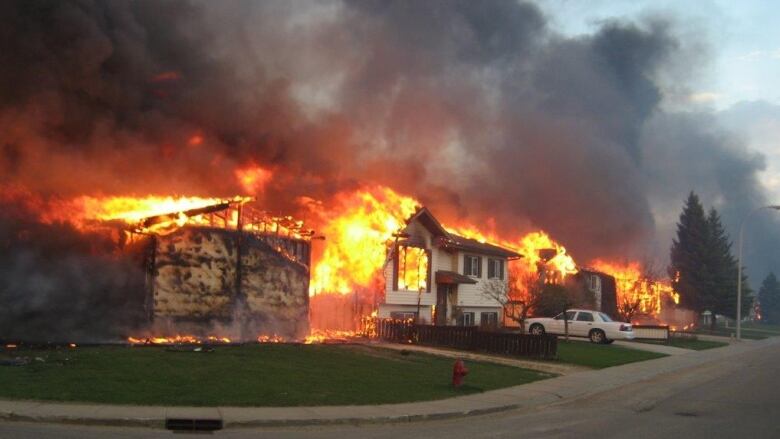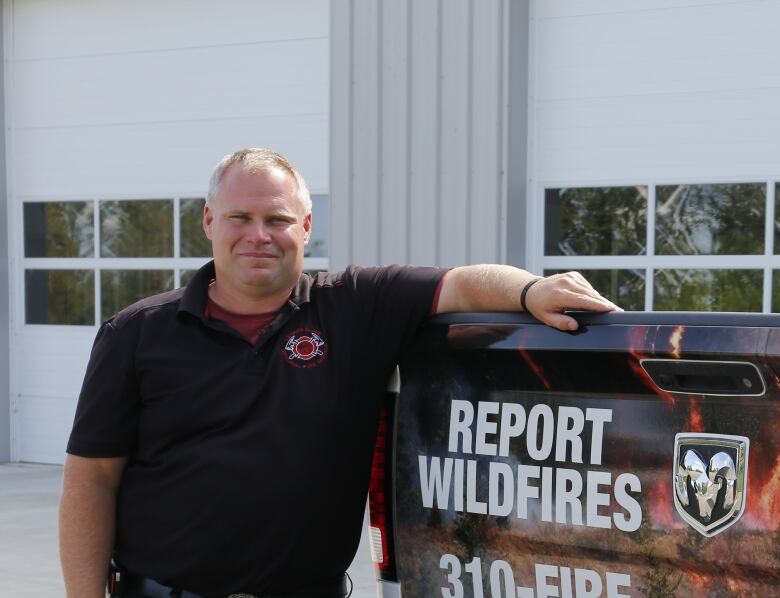Urge to live with trees, nature may be leading wildfire to our front doors
Wise choices of building materials and landscaping could limit potential for fire damage

At first glance,it looks like Mike Flannigan is playing in a pile of dry garden woodchips on the campus of the University of Alberta, but really it's science atwork.
"We have a simple test. If I drop to my kneesand then stand upif my knees are wet, it won't burn."
The University of Alberta professor ofwildlandfires says whatwe place in our gardens could make the difference between our homescatching on fire or not.
- Ideas|Listen to the wildfires documentary 'World On Fire'
- The 180 |'There was so much stuff': the 'second disaster' of unwanted donations
"Fire is opportunistic. It finds a path, it probes, it searches."

After the devastating fire of 2011 in Slave Lake,Alta.,Flanniganrecalls seeing the front walk and driveway of one home in the community lined with mulch. That led the fire right to the front door, but the home's green lawn was untouched.
"It just needed a wick, it just needed a path and away it went."
In recent days, images of the devastationleftby the wildfire in FortMcMurray,Alta., where entire city blocks were destroyed,have seemed eerily similar to those ofSlave Lake after its fire five years ago.
The Slave Lake wildfire cost an estimated $700 million in damage. One of the 374 buildings lost was a fire hall.
"Looking back on it, a bunch of spruce trees led right up to it. We had a bunch of pallets that we used for training stacked up maybe 10 metres away from the fire hall," says Lesser Slave regional fire Chief JamieCoutts.
The building,made of asphalt shingles andclapboardsiding, was constructed with the wrongkind of materials,Coutts said.
Five years and $3 millionlater, it's a different story.
Changing landscaping around buildings

"Our new fire hall ismetal everything and there's no trees around it and the grass is kept short," Coutts said.
This is a technique dubbed FireSmart across Canada and Firewise in the United States.
But Coutts says no matter what you call it,it boils down to returning to thelessons that kept Canadian pioneers alive.
"Homesteaders would come out and they would say:'Down this line,they would cut all the trees down and that would be your field starting here. Then the woods starts there.'"
Coutts says ourlove fornature and desire to live alongside trees puts us in danger, enablingfire to arrive atour front door.
"To a forest fire, houses are just another kind of tree. So there's nothing special about them, it's a burnable piece of material."
The sooner we look at our homes as potential fuel for a wildfire, the better,Couttssays.
What homeowners can do

Coutts believes Canadians must push back the bush and create fire breaks around communities.
Meanwhile, individual homeowners need to get smarter about building materials and landscaping toprevent megafires in the future.
Coutts suggests removing items that can burn from the first 10 metres around your home, including woodpiles and shrubs.
When it comes to the exterior walls or shell of your house, Coutts says metal, stucco, brick and concrete are preferable to wood and vinyl siding.
Deadly lesson from Down Under
Some homeowners in Australia have gone even further in terms of fireproofing, creating private bushfirebunkers similar to underground tornadoshelters in North America.
The catalyst for a move to bunkers andstricter building codescame in February 2009, when the Black Saturday bushfires swept across the state of Victoria,killing 173 people and injuring 400 more.
Theywere the worst wildfires Australia ever experienced, saysKevin Tolhurst,associate professor in fire management and ecology at the University of Melbourne.
Tolhurst says thefire's intensity wasoff the charts.Those charts had measuredfire intensity with five categories:low, moderate, high, very high, and extreme, saysTolhurst.
But when the Australians realized the firewas two tothree times hotter than "extreme,"they were forced to change thefire warning system, adding a"code red" or "catastrophic" category.
More intense fires
Tolhurst, whoearned the Order of Australia for his insights into fire, says the intensity of modern fires is beyondour planning and our design criteria and that "all bets are off."

Flannigan agrees. He's seeing a similar growth in intensity in therecent catastrophic fires in Canada.
When it comes to sifting through the aftermath of a fire in places likeFort McMurrayorSlave Lake,Coutts says in some cases which houses are left standing and whicharen't can be explained.
"We look at overhead pictures and say ... 'Remember how that house was built and it had wooden decks all around it or remember that guy who had three winters' worth of firewood stored underneathhis deck or that yard where there was 150 spruce trees on the lawn.'"












_(720p).jpg)


 OFFICIAL HD MUSIC VIDEO.jpg)
.jpg)



























































































